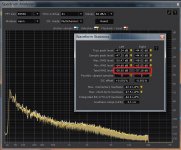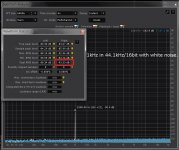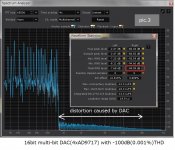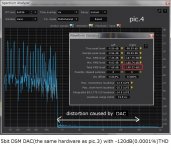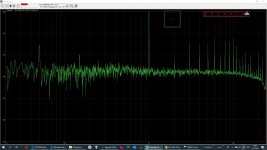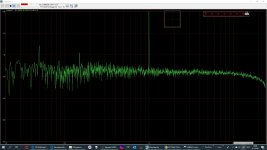Hearing is not linear enough to draw such a conclusion. It is already well established and generally accepted from published studies that some people can hear 16-bit quantizing noise, and at much lower volume levels than 100dB. In fact, 100dB would be likely too loud to hear it, IME. At some point loud sound becomes deafening and is counterproductive to hearing small details, again IMHO.
Have you got any references to such studies? I would like to look them up.
When converting a signal from pcm to dsd the level has to be lowered because dsd doesn't do well when there exist a large number of 1's or 0's in succession, which would be the case when pcm would just plainly be converted to dsd. So 0dB pcm, a standard test signal, would without adjustment in level, convert to a clipping dsd signal. Nothing more.
I don't know how JRiver converts pcm to dsd and if it always automatically lowers the signal 6dB in level or not, before converting it to dsd, but I do know that any 1 bit no-dac, by nature, goes into clipping when fed too many 0's or 1's in succession. The result is easily observed by an increase of 3rd, 5th, 7th and so on harmonics, but even orders go up as clipping does.
The main problem is the generation of the DSD signal. DSD was originally generated with high-order single-bit sigma-delta modulators. Without any special countermeasures, those burst into low-frequency oscillations when you drive them too hard. Feedback sigma-deltas with state variable limiting sort of keep working, but with very much degraded noise shaping: they revert to first- or second-order noise shaping when driven too hard.
Have you got any references to such studies? I would like to look them up.
As to whether or not 16-bit quantizing noise is audible by some people, Scott Wurcer cited confirming studies in Blowtorch some time ago. There is no disagreement among the guys over there on this issue.
IIRC correctly, in the early days of CDs, some were manufactured without dither. It was discovered that some people could hear the quantizing noise, and dither then became requisite.
The most recent summary article on high end audio requirements and hearing that I am aware of is at (a free download):
AES E-Library >> High-Resolution Audio: A History and Perspective
...although I think it is somewhat behind what can be shown today.
IMHO, it is fairly easy to demonstrate that it is possible to hear distortion somewhere down around -120dB. I would be happy to explain how if anyone wants to give it a try. An FFT analyzer and a good Sabre dac with register level access are needed.
Last edited:
Hearing is not linear enough to draw such a conclusion.
What I meant is residual noise in silence. The 1st pic is my music file ripped from vinyl released in the 50'. It has of course relatively large residual noise(-58dB). This is audible for me. But if you can decrease residual noise by 10dB(-58-10=-68), It's gone away, i.e., non-audible. That's why -93dB is completely non-audible for me.
But I have recently found human ear isn't so simple as you wrote. I have been a multibit lover for 20 years like pcm1704. After being obsolete, I managed to design an alternative one with AD9717 which can output both PCM and DSM. PCM is almost -100dB THD while DSM is -120dB THD. I thought DSM is an alternative of PCM mode because I'm a big fan of pcm1704.
Measurement data and listening test blew away my prejudice. DSM was way better than PCM mode and pcm1704 in my 20 years' memory. Pic.3(PCM) and pic.4(DSM) is distortion caused by DAC. The input is real music(pipe organ) with large spectrum in low frequency, where the bandwidth is limited to 800Hz. If your DAC is perfect, no spectrum exists above 800Hz. Real DAC outputs some distortion caused by real music. Both distortion levels are very small(PCM=94dB, DSM=108dB) but I can completely hear the difference. The lower, the better. If I can manage to have more than -120dB, I will name it a paradise.
Attachments
No I am still waiting for those..Are those tests done with the potato chips you ordered?
That would have been fast shipping.
Klaus
What I meant is residual noise in silence. The 1st pic is my music file ripped from vinyl released in the 50'. It has of course relatively large residual noise(-58dB). This is audible for me. But if you can decrease residual noise by 10dB(-58-10=-68), It's gone away, i.e., non-audible. That's why -93dB is completely non-audible for me.
But I have recently found human ear isn't so simple as you wrote. I have been a multibit lover for 20 years like pcm1704. After being obsolete, I managed to design an alternative one with AD9717 which can output both PCM and DSM. PCM is almost -100dB THD while DSM is -120dB THD. I thought DSM is an alternative of PCM mode because I'm a big fan of pcm1704.
Measurement data and listening test blew away my prejudice. DSM was way better than PCM mode and pcm1704 in my 20 years' memory. Pic.3(PCM) and pic.4(DSM) is distortion caused by DAC. The input is real music(pipe organ) with large spectrum in low frequency, where the bandwidth is limited to 800Hz. If your DAC is perfect, no spectrum exists above 800Hz. Real DAC outputs some distortion caused by real music. Both distortion levels are very small(PCM=94dB, DSM=108dB) but I can completely hear the difference. The lower, the better. If I can manage to have more than -120dB, I will name it a paradise.
That's a novel way of measuring distortion, nice figures as well!
How can you tell what part is filter leakage (that the righ term?) and what part is distortion?
Nice going!
......... where the bandwidth is limited to 800Hz. If your DAC is perfect, no spectrum exists above 800Hz. Real DAC outputs some distortion caused by real music. Both distortion levels are very small(PCM=94dB, DSM=108dB) but I can completely hear the difference. The lower, the better. If I can manage to have more than -120dB, I will name it a paradise.
Hi, I don't know if this has been asked, just want to know what kind of FFT software that you post here? Looks very fantastic and professional
A couple of years back there was some interest in PCM->PWM conversion chips. Here's a cheap implementation of the STA350 which is a digital power amp (FDA) and can be adapted into use as a noDAC, fed directly with PCM. It needs a step-down transformer for bal-SE and some additional LC filtering to push the carrier frequency well into the noise.
STA350?????? ??? ?? USB?? ??2.1??/ 2.0??-???
STA350?????? ??? ?? USB?? ??2.1??/ 2.0??-???
That's a novel way of measuring distortion, nice figures as well!
How can you tell what part is filter leakage (that the righ term?) and what part is distortion?
Nice going!
You can regard everything comes from DAC because bandlimited test signal is processed super brick-wall FIR by RX4, i.e., no filter leakage exists above 800Hz. You can see the white line(L channel) has no spectrum above 800Hz at pic.3 and pic.4. Below 800Hz, a while and blue(DAC output) are the same FFT(you can see only blue). Above 800Hz, both are different because of DAC oriented distortion. I'm sure real music is the best probe to qualify true DAC performance. The measurement data is relevant to SQ as long as I have tested.
I did the same measurement as post#2004 on another DAC, including a CD player I have. Even the same DAC chip(pcm1792) has a different result because analog circuit including power quality can affect total performance. Generally speaking, DSM is superior to PCM(R2R). Pcm1792 in DSD mode is better than those in PCM mode. It's a good idea to use pcm1792 in DSD mode together with PCM to DSD converter by FPGA to achieve high performance with low cost, DIY friendly package, and no NDA. ES9038(made in eBay) is also a good choice if it doesn't force you to sign.
Hi, I don't know if this has been asked, just want to know what kind of FFT software that you post here? Looks very fantastic and professional
I love to use RX4 by iZotope to analyze DAC performance and process my ripped data from vinyl, where much scratch noise and clicks exist, but RX4 can make them brand-new without degradation of SQ. The latest version is probably RX7. I don't think the latest is always the best. I'm very satisfied with RX4, don't want to do grade up.
aditional imformation on #2009
Pcm1792 in PCM mode is, of course, processed by DSM(6 bit). DSD mode is simple 64 taps FIR topology which can be the best one to achieve anti "true IMD" circuit. I measured pcm1792 in DSD mode, but haven't measured in PCM. It needs some modification on my DIY PCB. The only data I have is done with a CD player, which is far inferior to DSD mode of my DIY PCB.
Pcm1792 in PCM mode is, of course, processed by DSM(6 bit). DSD mode is simple 64 taps FIR topology which can be the best one to achieve anti "true IMD" circuit. I measured pcm1792 in DSD mode, but haven't measured in PCM. It needs some modification on my DIY PCB. The only data I have is done with a CD player, which is far inferior to DSD mode of my DIY PCB.
A couple of years back there was some interest in PCM->PWM conversion chips. Here's a cheap implementation of the STA350 which is a digital power amp (FDA) and can be adapted into use as a noDAC, fed directly with PCM. It needs a step-down transformer for bal-SE and some additional LC filtering to push the carrier frequency well into the noise.
STA350?????? ??? ?? USB?? ??2.1??/ 2.0??-???
Interesting.
Last edited:
I love to use RX4 by iZotope to analyze DAC performance and process my ripped data from vinyl, where much scratch noise and clicks exist, but RX4 can make them brand-new without degradation of SQ. The latest version is probably RX7. I don't think the latest is always the best. I'm very satisfied with RX4, don't want to do grade up.
Thanks for the info. BTW what soft do you use to rip vinyl?
Last edited:
As to whether or not 16-bit quantizing noise is audible by some people, Scott Wurcer cited confirming studies in Blowtorch some time ago. There is no disagreement among the guys over there on this issue.
IIRC correctly, in the early days of CDs, some were manufactured without dither. It was discovered that some people could hear the quantizing noise, and dither then became requisite.
The most recent summary article on high end audio requirements and hearing that I am aware of is at (a free download):
AES E-Library >> High-Resolution Audio: A History and Perspective
...although I think it is somewhat behind what can be shown today.
IMHO, it is fairly easy to demonstrate that it is possible to hear distortion somewhere down around -120dB. I would be happy to explain how if anyone wants to give it a try. An FFT analyzer and a good Sabre dac with register level access are needed.
It is certainly true that very soft passages of a recording played at a very high full-scale level will be audibly distorted when they are quantized to 16 bits without dither. Section 1.1 of the freely downloadable article you referred to also refers to maximum levels in the 120 dB ballpark. I didn't find anything in it about audible quantization noise or quantization distortion at low full-scale levels.
The bit about high sample rates in section 4 is illogical, like many articles about high sample rates. In section 4.1, the author argues that ultrasonics are inaudible under all practical circumstances, but one page later, in section 4.4, she suggests that the ultrasonic pre- and post-ringing of phase linear filters harms the sound. Seems like a contradiction in terms to me.
By the way, she doesn't mention intersample overshoots anywhere. These are also reduced with high sample rates.
I didn't find anything in it about audible quantization noise or quantization distortion at low full-scale levels.
I am not aware of the subject having been formally studied in great detail.
As was pointed out by someone in the perceptual testing field, if as much money were spent on researching hearing as the food industry spends on its research, most of the remaining disagreements and questions about audio perception would probably already be settled.
Not much I can do about it myself. I have invited people to come listen for themselves at my Northern California location, but so far no takers. The system is very low distortion, and many small details can be heard if one has learned how to listen for them. We can record, mix, master, measure, blind test, etc. Easy to convince people when they hear and measure for themselves. Virtually impossible to convince people who firmly hold other beliefs and or whose only practical option is to ask for studies that often don't exist.
Regarding the recent AES publication with apparent contradictions, as a review paper it probably summarizes things that have been written about, but are less than fully understood. Perceptual testing of humans is complicated, time consuming, expensive, difficult, and requires expertise from multiple fields. No entity seems much interested in funding it.
Last edited:
Thanks for the info. BTW what soft do you use to rip vinyl?
I also use RX4 to clean up my ripped vinyl. There are two steps. The 1st is de-click, which removes inevitable clicks. The 2nd is de-construct, which separates meaningful signal from noise. After separating, it decreases noise only, then you can improve SNR by almost 6dB. In other words, de-construct means anti-scratch noise. The process is manually done because clicks and scratch depend on each vinyl. It's better to use human intelligence than AI.
I also use RX4 to clean up my ripped vinyl. There are two steps. The 1st is de-click, which removes inevitable clicks. The 2nd is de-construct, which separates meaningful signal from noise. After separating, it decreases noise only, then you can improve SNR by almost 6dB. In other words, de-construct means anti-scratch noise. The process is manually done because clicks and scratch depend on each vinyl. It's better to use human intelligence than AI.
Thank you, what software/programm do you use to rip vinyl?
For all of you wondering where the audible distortions with many no-dacs, when playing at low volumes, extremely dynamic music, or when fade in or fade outs are at play (especially at high dsd rates):
Just a quick look at how a single ended Potato Semi flip flop behaves with different algorithms by HQPlayer, having a simple 2nd order analog output filter.
The test signal is 1KHz, -60dB @ DSD512.
The first image is taken with the DSD7 +256FS modulator,
the second with the AMSDM7 512+FS type, both Poly-sinc-2s.
Just a quick look at how a single ended Potato Semi flip flop behaves with different algorithms by HQPlayer, having a simple 2nd order analog output filter.
The test signal is 1KHz, -60dB @ DSD512.
The first image is taken with the DSD7 +256FS modulator,
the second with the AMSDM7 512+FS type, both Poly-sinc-2s.
Attachments
@xx3stksm: Hi ... I have been reading your latest posts and - this may be very obvious but just to make sure - when you say "DSM" do you then mean delta-sigma-modulation ... or can you say what DSM is an acronym for?
Cheers & thanks,
Jesper
Yes, DSM is Delta Sigma Modulation with 1bit,2bit, and up to 6bit resolution. DSD I mean is 1bit DSM(2 values, 0 and 1) used for no DAC project. 2bit DSM means 3 values, 01(positive),00(zero), and 10(negative).
- Home
- Source & Line
- Digital Line Level
- The Best DAC is no DAC
